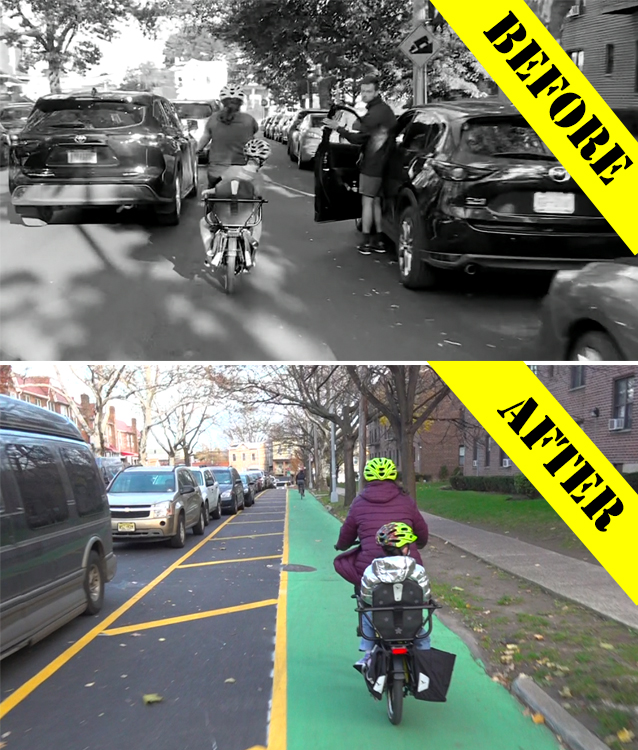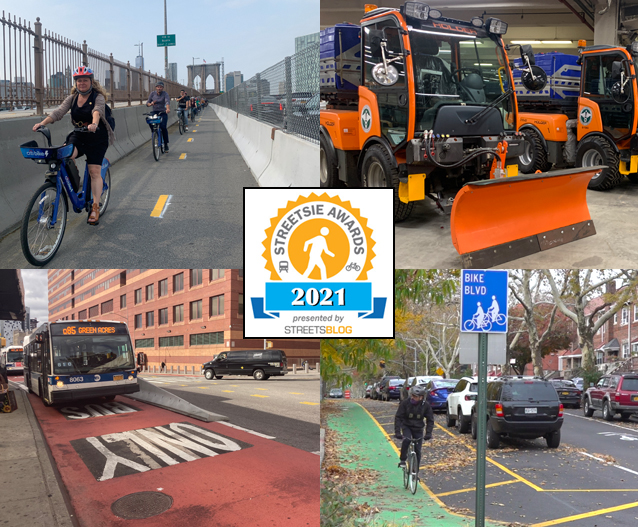The Streetsies are back! After a year of Covid, we've decided to fully restore our beloved end-of-year awards show to honor the heroes of the livable streets movement, wag a finger at the villains, and generally roundup a year's worth of events and projects that you might have forgotten. All week long, we'll be rolling out this year's awards. Click here for this year's archive.
We know it's common knowledge that Streetsblog is constantly nitpicking every single thing the state or city Department of Transportation does. In short, we're just a bunch of Negative Nellies who hate everything.
But it's not true! We love the hard-working people of both DOTs — and we love it when they do amazing work to make our roads safer, our public spaces more glorious and our air less polluted because they've encouraged so much cycling, walking and transit use.
One caveat: There were many great announcements of projects this year (such as the MTA's announcement that it will add four Metro-North stations in The Bronx), but this list includes only completed projects. (We promise to remember those new depots at Co-op City, Morris Park, Parkchester and Hunts Point if they open as promised in 2025.)
So without any further ado, let's celebrate ... the best projects of the year!
And the nominees are:
The 39th Avenue Bike Boulevard
You read our advance coverage and you've seen Clarence Eckerson's Streetfilms video, but unless you've had a chance to bike — or, more important, live — along the 10-block section of Sunnyside's 39th Avenue that was transformed into a "bike boulevard," you really have no idea of the quiet (nota bene!) revolution happening over there.

Yes, there are new bike lanes — and wide ones! — on the stretch between Woodside Avenue and 43rd Streets, but the key element to this design is the diverter that forces drivers to turn off the roadway at 50th Street. As a result, what was once a shortcut for drivers avoiding Northern Boulevard has come what it was designed to be 100 years ago: a quiet residential streets where you could send a kid to the corner store for a loaf of bread and be confident that he'll return unscathed.
How many residents of this city have that level of confidence?
It's understandable that some residents who own cars were initially dubious about the design — change is hard! — but now that the bike boulevard is in place, any concerns must simply be drowned out by the majority of residents who now live in a calm neighborhood again.
Given that almost no parking was removed, and that every single house can still be accessed (albeit sometimes by redirecting yourself around the block), we find it incomprehensible that the city DOT would not install literally tens of thousands of such "boulevards" in residential neighborhoods all over town.
The Brooklyn Bridge bike lane
As good as the 39th Avenue bike boulevard is, it will ultimately serve far fewer people every day than our next nominee, the dedicated bike lane on the Brooklyn Bridge.
Caveat: Why did this take so long? Advocates for cyclists and pedestrians and tourists and even belt and water vendors had been complaining about crowds on the narrow shared bike and pedestrian path on the fabled span for more than a decade (the New York Times famously called the path "the Times Square of the sky" in 2016, and you know how late the Times is to most stories).

Another caveat: This two-way lane is only eight-feet wide, which is the bare minimum width as far as the National Association for City Transportation Officials is concerned.
But that aside, it's simply wonderful for cyclists to have a direct route from Brooklyn Heights to the area of Manhattan below Canal Street, which was always tricky to get to using the Manhattan Bridge. And cyclists are obviously responding, with ridership way up on the bridge without an apparent dropoff on the Manny B, according to the Department of Transportation.
And having a roadway, just like cars, allows cyclists to finally feel like they're equals. Of course, the feeling is fleeting, but while you're on the bridge, it feels good.
The Jamaica/Archer Avenue busway
If you want to talk about high-impact projects, there's rarely anything better than getting cars out of the way of New York's sclerotic buses. And on the paired busways on Jamaica Avenue and Archer Avenue in Jamaica, anything that helps buses helps 250,000 people per day.

The city DOT deserves special credit here because the mayor initially only proposed a busway on Jamaica Avenue, but then expanded it to Archer, too, after residents complained.
And let's not underestimate how important better bus service is to Queens residents. According to the MTA, the Q24 bus, which operates on both Jamaica and Archer avenues, had an average peak speed of 6.7 miles per hour back in February, 2018. In October, 2021, just before the installation of the busway, that speed had actually dropped to 6.6 miles per hour. And the Q56, which runs on Jamaica, also lost one-tenth of a mile per hour, dropping from 5.9 to 5.8 mph.
No More MTA Bike Pass BS
It didn't get much coverage at the time, but the MTA made cycling easier with a stroke of the pen, eliminating a silly rule that required cyclists to buy a $5 permit in order to bring their bikes on Metro-North and Long Island Rail Road trains. It wasn't that the pass was so onerous, but (speaking not only for ourselves) so many people would never have the pass on them and then have to buy a new one at Penn Station or Grand Central as they headed upstate or to Montauk for the weekend.
It's just so much better this way. Check out the MTA's bike web page here.
Permanent open streets, restaurants, culture
The pandemic allowed the de Blasio administration to use emergency powers to open up roadways for recreation, socially distant strolling, outdoor dining and even seeing a performance. But the popularity of these roadway uses led the administration to move ahead to make the changes permanent.

Now, the problem is that not every open street is getting the support it needs to remain truly a neighborhood resource like they are on 34th Avenue in Queens or Avenue B on the Lower East Side, but the fact that the city is creating permanent open space is a plus (however flawed, weak or compromised the designs are).
And making the open restaurants program permanent will mean real regulations that not only require eateries to pay for the public space they occupy (unlike private car owners!), but potentially give the public recourse if the dining areas stay open too late or don't clean up after themselves.
Plus, a permanent open culture program means that we can keep enjoying free shows, like Intar Theater's "Oso Fabuloso & The Bear Backs" that we caught in June on W. 52nd Street, Cornfield Dance's "Spaced Out," also in June, but on E. 11th Street, and Jiva Dance's "B’Rhythm" from August on Brooklyn's Garfield Place.
Sanitation's 'Narrow' Vision
We complained mightily last year when the Department of Sanitation made cyclists wait, sometimes for days and days, for bike lanes clear of snow after storms.

Well, Commissioner Ed Grayson apparently heard our pleas because this year, the agency is leasing 30 narrow-gauge, nimble snow plows for not only sweeping away snow, but for pre-treating bike lanes with brine before them. We don't know if this small army of equipment can reduce cyclists' second-class citizen status, but it's a start.
Also unknown: Will pedestrians still have to wait days for DSNY crews to clear corners and bus stops to walkers are no longer discriminated against? We'll be watching.
And the winner is...
Sorry, folks, we can't chose between the two finalists — the bike boulevard and the Brooklyn Bridge bike lane — so we're going to let you. Please vote below. Polls are open until Thursday, Dec. 23 at noon.






